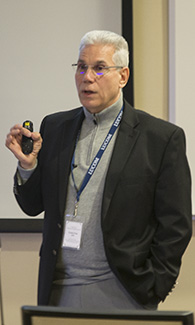Tuesday, November 1, 2016
Center for Research hosts expert in respiratory and molecular functions
Tue, 01 Nov 2016Asa Keimig, LUCOM Marketing and PR Coordinator
 The LUCOM-Center for Research (CR) continues in its second year of hosting the Biomedical Frontiers Seminar Series. On Thursday, Oct. 27, the CR hosted Timothy E. Weaver, Ph.D., Professor of Pediatrics and Associate Director for the Division of Pulmonary Biology at the Cincinnati Children’s Research Foundation and Department of Pediatrics at the University Of Cincinnati College Of Medicine.
The LUCOM-Center for Research (CR) continues in its second year of hosting the Biomedical Frontiers Seminar Series. On Thursday, Oct. 27, the CR hosted Timothy E. Weaver, Ph.D., Professor of Pediatrics and Associate Director for the Division of Pulmonary Biology at the Cincinnati Children’s Research Foundation and Department of Pediatrics at the University Of Cincinnati College Of Medicine.
“Our speaker Dr. Tim Weaver has a real interesting background,” said Joseph Brewer, Ph.D., Associate Dean for Research. “With training in embryology, he moved to Cincinnati where he did his Ph.D. in developmental biology, he did some work in molecular biology, and then stayed on as faculty, rose through the ranks, and he’s been a professor there in pediatrics for a number of years and currently leads the division of pulmonary biology at Cincinnati Children’s Hospital.” Dr. Brewer and Dr. Weaver originally met at a science conference in Chicago several years back. “He has had tremendous success over many years and I thought what better place than LUCOM with the quality of his work, but also the unique connection to his faith and what we stand for,” added Dr. Brewer.
Dr. Weaver presented “Intracellular Trafficking of Lipids: Molecular Choices that Govern the Destination.” He focused his presentation on the lungs which consists of two parts: conducting airways that divide, and then while dividing, narrow and terminate into sac like structures, called alveoli, at the business end of the gas exchange. “Every alveolus is involved in a capillary network which facilities those gas exchanges and if you lay out all these alveoli, it would cover the surface of a tennis court,” said Dr. Weaver. “It’s an incredible structure, a structure which was designed by God.”
Part of his research covered two protein components, surfactant protein B (SPB) and surfactant protein C (SPC), and how the mutations in SPC are associated with the development of interstitial lung disease in infants and children and the development of pulmonary fibrosis in adults. These autosomal dominant mutations cause protein misfolding, which causes endoplasmic reticulum (ER) stress and contributes to pathogenesis and mechanisms that aren’t fully understood yet by his research team.
During his post-doctorate studies, Dr. Weaver and the research team at the University of Cincinnati discovered Surfactant Protein B (SPB). SPB is an essential lipid protein found in the lung surfactant. The loss of SPB expression is a very rare disease and is lethal. The lungs develop normally, but as soon as an animal is born they die because they can’t form the lipid film that covers the alveoli surfaces. Animals and infants alike can’t form that film because SPB is needed to transport lipids to the surface to form the film. Unlike animals, infants that have mutations in SPB can be ventilated and then given then SPB for about six months after which they would be old enough to receive a lung transplant. A lung transplant is currently the only treatment available.
Dr. Weaver received his bachelor of science (BS) in Biology from Bob Jones University in 1975, his master of science (MS) in Embryology from Hahnemann Medical College in 1979, his Doctorate of Philosophy (Ph.D.) in Developmental Biology in 1983, and his post doctorate in Molecular Biology from the University of Cincinnati College of Medicine in 1986.
Cincinnati Children’s Hospital is largest children’s hospital in the U.S. and second largest in terms of funding.